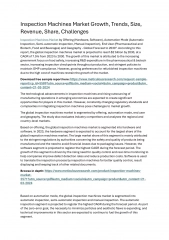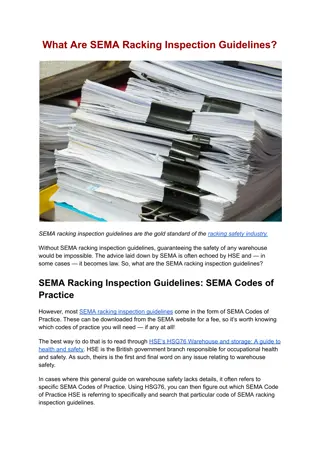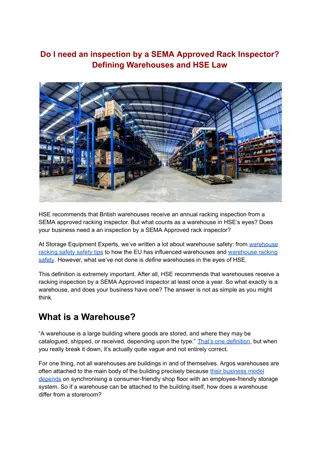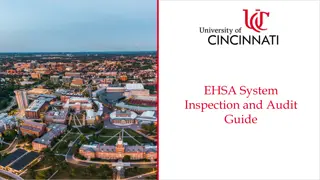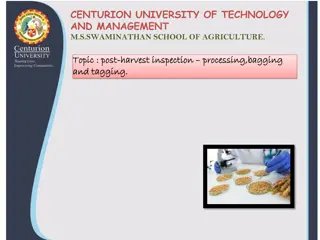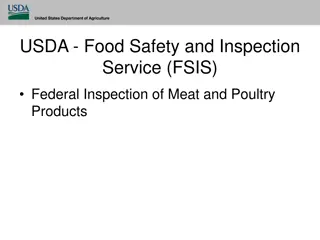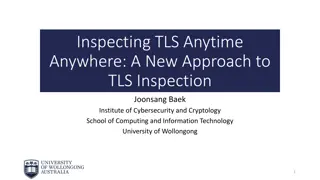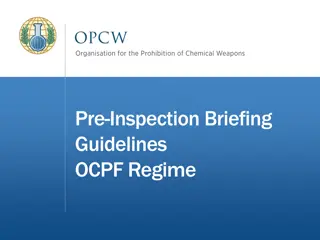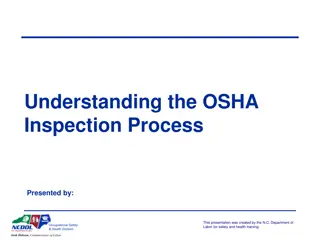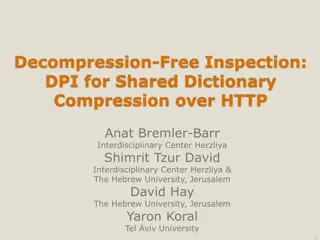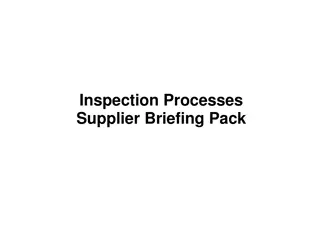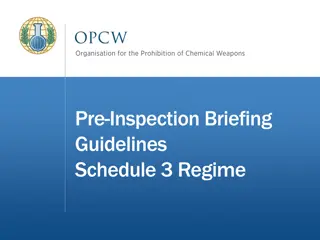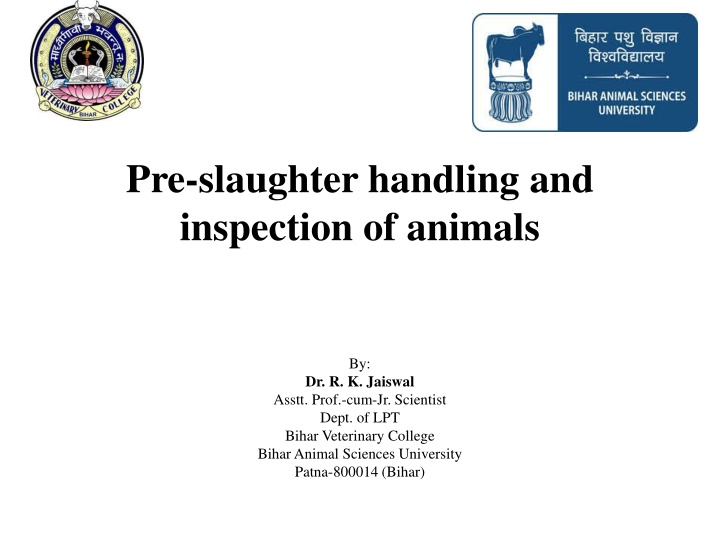
Efficient Pre-Slaughter Handling and Inspection of Animals
Learn about the importance of pre-slaughter handling and inspection of animals in ensuring meat quality and animal welfare. Topics covered include transportation, pre-slaughter rest, and ante-mortem inspection. Discover guidelines to prevent cruelty, enhance meat quality, and maintain animal health during the pre-slaughter process.
Download Presentation

Please find below an Image/Link to download the presentation.
The content on the website is provided AS IS for your information and personal use only. It may not be sold, licensed, or shared on other websites without obtaining consent from the author. If you encounter any issues during the download, it is possible that the publisher has removed the file from their server.
You are allowed to download the files provided on this website for personal or commercial use, subject to the condition that they are used lawfully. All files are the property of their respective owners.
The content on the website is provided AS IS for your information and personal use only. It may not be sold, licensed, or shared on other websites without obtaining consent from the author.
E N D
Presentation Transcript
Pre-slaughter handling and inspection of animals By: Dr. R. K. Jaiswal Asstt. Prof.-cum-Jr. Scientist Dept. of LPT Bihar Veterinary College Bihar Animal Sciences University Patna-800014 (Bihar)
Introduction Pre-slaughter handling of meat animals includes procedures adopted during 1. Transportation 2. Pre-slaughter rest 3. Ante mortem inspection.
Transport of food animals Animals are taken to the slaughter house either on hoof or through road/rail/sea transport. Food animals must not be subjected to cruelty. Legislations against cruelty to animals. Road or rail --avoid overcrowding--suffocation and physical injuries in the form of bruises, fractures etc.. Tying or chaining of the animals is to be avoided. Specially designed trucks and wagons
Pre-slaughter rest Pre-slaughter rest is the period before slaughter when animals are rested in order to improve the meat quality and reduce the chances of contamination with gastrointestinal bacteria. During pre-slaughter rest, fatigue could have negative influence on protective functions of the animals (low immunity). Causes rapid penetration of the microorganisms especially E. Coli through mucous membrane of the intestine to the blood stream and ultimately to the organs.
Normal feeding and resting for 48 hours brings gradual freeing of muscles and other organs from microorganisms, improve bleeding and keeping quality of meat. Pre-slaughter rest also helps in preserving glycogen level in the muscles and during the later phase this glycogen undergoes anaerobic respiration and results in production of lactic acid which has mild preservation effect on meat quality.
Under stressed conditions muscles do not receive enough oxygen which leads to higher lactic acid production often associated with comprised quality in terms of colour, texture and water holding capacity.
Ante-mortem inspection It refers to inspection of food animals conducted prior to (12 to 24 hr in lairage) slaughter to ascertain fitness or otherwise of the animals for slaughter. Objectives of ante-mortem inspection To detect the animals suffering from infectious or scheduled diseases such as FMD, Rabies, Anthrax, etc. To detect diseases causing toxic or infectious conditions and which may escape detection in post mortem examination. .
To prevent outbreaks of food poisoning resulting from the consumption of meat from animals which were ill at slaughter To make post-mortem inspection more efficient and less laborious. To document information on animal diseases prevalent in the region. To prevent the use of meat from animals suffering from febrile condition
Facilities for conducting ante- mortem inspection Identification of the animals Lairage: designed, well lighted and ventilated with isolation pens Assistant staff and veterinary officer Well designed code on veterinary ante-mortem inspection procedures, judgement principles Documentation of findings Light: 540 lux
Procedure for ante-mortem inspection Can be carried out in two stages: Stage-I: General examination The animals are to be examined collectively to assess the overall health status so as to segregate them into three groups: 1) Healthy 2) Unhealthy (diseased) 3) Apparently healthy (doubtful cases) The animals are examined while they are at rest and also in motion They are observed for the gait, posture, fatigueness and for their response to external stimuli.
They are examined for abnormal behavior like walking in circles, state of alertness, symptoms of tiredness and agitation Animals are examined for abnormal discharge from natural orifices like eyes, nose, mouth, anus, vagina etc. and/or swellings on any part of the body. It is also important to observe for any evidence of cruelty to animals such as any sign of bruises, torn skin, and fractured bone indicating carelessness during transportation.
At the end of the first stage of examination, healthy animals are cleared as fit for slaughter whereas the other two groups are taken to the next stage of examination. Stage-II. Detailed clinical examination The animals classified as Unhealthy (diseased) are subjected to further examination to correctly diagnose the illness Animals placed in group three (Apparently healthy or doubtful cases) are examined
To ascertain whether these animals are really sick and if so what could be the nature of illness. Animals are subjected to the following investigations: (i) Temperature, pulse and respiration rate should be recorded and animals suffering from fever must be retained for treatment preferably outside the meat plant. (ii) The lymph nodes are palpated and examined for any swelling and abnormalities and on this basis the animals are either rejected or passed with clear instructions for careful post-mortem examination
(iii) Pregnant animals or animals having delivered a calf within the last 48 hours are not permitted for slaughter. Animals undergoing treatment or with a recent history of treatment as also experimental animals are not to be slaughtered unless a no objection certificate has been issued by veterinarians. (iv) Blood, urine and faeces samples to be drawn for laboratory tests (v) Pathognomonic clinical symptoms of the diseases for suspected animal to be carefully studied. (vi) The species, class, age, condition, colour and markings re recorded in case of diseased or sick animals and in case of the animals in poor condition.
Diseases and abnormalities encountered in ante- mortem inspection
Judgment decisions at ante-mortem inspection Post ante-mortem inspections, the animals can be subjected to any of the following three decisions. 1. Passed/Accepted/ Fit for slaughter: The animals free from any disease and normal can be directly sent for slaughter. 2. Rejected/ Condemned/ Unfit for slaughter: Animals suffering from fever (106 degrees F or more), emaciated or dead animals, immature or pregnant animals are considered unfit and not passed
Animals with symptoms of diseases are not sent for slaughter. 3. Suspect: Animals falling under this category are those for which decision regarding fitness for slaughter cannot be made at the ante-mortem inspection stage. The circumstances. following possibilities exist under these
(a) Slaughter under special precautions: Animals under suspect category if having symptoms of diseases. (b) Delayed/Detained slaughter: If the animals require treatment, or have history of recent treatment/vaccination, animals in febrile condition, fatigued and exited state may require treatment before they are slaughtered.
(c) Segregated slaughter: Such decisions are made under special conditions such as dirty stock or animal suspected for some contagious diseases etc. Such animals are slaughtered at the end of the day s kill or separately slaughtered and a thorough post- mortem examination is performed. (d) Casualty and emergency slaughter: Casualty slaughter is required when an animal is not in acute pain or immediate danger of death but affected with a more chronic condition like benign superficial tumors, obturator paralysis and post- partum paraplegia etc.
When an animal is in acute pain or suffering from condition like, fractures, severe injuries, uterine prolapsed etc., where a delay in slaughter would be contrary to the animal welfare, then animals requires emergency slaughter. Prolonged recumbency in cows and sows after parturition, abscess formation in pigs due to Corynaebacterium pyogenes, pregnancy toxaemia and enterotoxaemia in sheep and injuries and affections of udder and uterus in cattle are the several other causes of emergency slaughter.

